Dear BPBS,
I've been hearing more and more about UST projectors. Are they better than regular projectors? I've thought about getting a projector so I can get a really big screen for movies, but I don't want all the hassle of wires and installation. Are UST projectors any good? Also, do they have their own speakers or will I need a sound bar?
-Bill in Boston
Hi, Bill,
UST (Ultra Short Throw) projectors aren't particularly new technology. They've been around for home use since about 2014 and for business and classroom use even longer. But as costs have lowered and more manufacturers have entered the fray, UST projectors are becoming a popular alternative to large screen flat panel TVs and traditional projection systems.
The main difference between a UST projector and a traditional projector is how far from the wall or screen the projection unit has to be placed in order to produce a suitably large image. A traditional "long throw" projector may need to be placed 10 feet or more from the wall to create a 100-inch image. This means it either needs to be on a coffee table in the middle of the room (where it can get jostled or bumped), on a shelf toward the back of the room, or mounted on a ceiling. And since projectors need power and video sources connected, you'll need to run at least one (if not more) cables to the projector, which may get tricky.
> What's the Best UST Projector in 2022? Find out Here
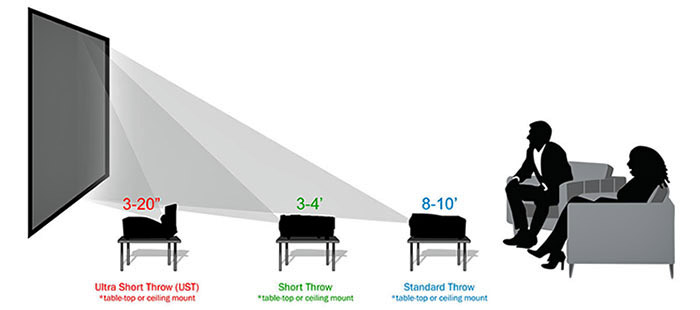
An Ultra Short Throw projector can produce a 100-inch image placed just a few inches from the screen. Some can even produce a 150-inch image as close as 12 inches from the wall. This means the projector can be placed on a stand, credenza or shelf at the front of the room, which is typically where your other devices like a cable box, Blu-ray Player or A/V receiver would be located. By placing the projector at the front of the room, you won't have to worry about complicated wiring or installation.
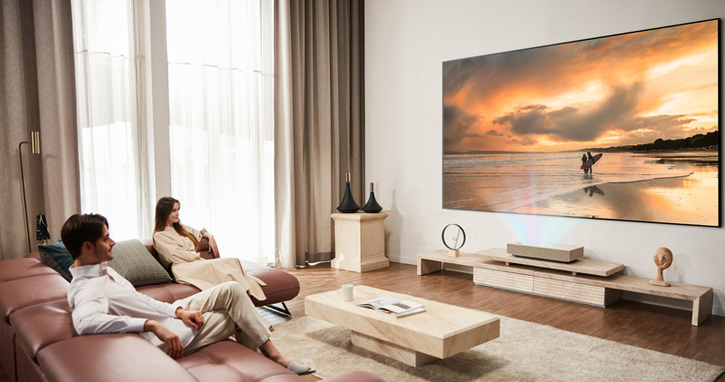
Although a UST projector can be powered by a traditional lamp, most of the UST projectors on the market today use a laser light source. This plus the fact that the whole projection system is fairly self-contained has led to UST projection systems being called "Laser TVs." Like a TV (and unlike most front projection systems), a UST projector typically has some sort of streaming apps built in, as well as a powered speaker system. Some even come bundled with a screen so no additional purchase is required.
As for the laser light source, UST projectors either use a single laser combined with a phosphor to create a white light source, or three separate lasers: one for each primary color. These lasers are then channeled through an optical assembly, comprised of parts such as lenses, prisms and mirrors to light up one or more imaging panels. This, combined with advanced digital processing, allows the projector to create that large image just inches from the projector.
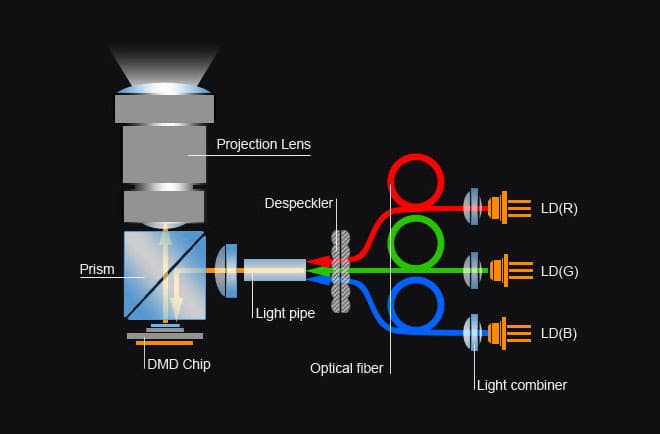
The actual imaging panels may be DLP (Digital Light Processing), LCD (Liquid Crystal Diode) or some form of LCoS (Liquid Crystal on Silicon). Lasers are generally superior to traditional lamps as they are brighter and last much longer than a traditional bulb. While a projector bulb may need to be replaced after a few years (2,500-5,000 hours of use), laser lighting units are expected to last 20,000 hours or more.
Many UST projectors offer 4K UHD resolution as well as some form of HDR (High Dynamic Range) support so they can take advantage of the highest quality streaming sources as well as 4K physical media (Ultra HD Blu-ray Disc). Some even support Dolby Vision HDR for an even more theater-like experience at home.
Also - you asked about the sound quality - since the projection unit is right near the screen, and directly in front of the viewer, the projector itself can provide the sound as well as the picture. This is not easy to do with a traditional projector which may be mounted on the ceiling or rear wall. And, because UST projectors have decent-sized cabinets, some UST projectors actually have pretty good sound systems built in. This also reduces system complexity and cost.
Several projector makers are teaming up with high-end sound companies in order to tweak the performance of the sound. The Formovie Theater UST projector has a built-in sound bar designed by British audio legend Bowers and Wilkins. This projector won the 2022 Laser TV Showdown for best picture in the Triple Laser category. It also delivered the best sound quality among all 14 projectors tested. You can find out more about the Formovie Theater UST projector on ProjectorScreen.com.
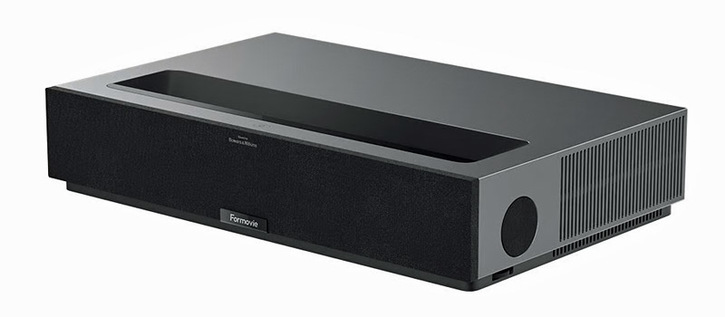
Other UST projectors, including the VAVA Tri-Chroma, ViewSonic X2000-4K and XGIMI Aura include sound systems designed and engineered in partnership with Harman/Kardon. These models were also judged to be in the top tier for sound quality in that UST projector showdown event. We'd always recommend that you pair a projector with a high quality component-based surround sound system. But if you're trying to stick to a budget, keep things simple or simply want to get by while you save up for a full-fledged surround sound system, there are several good-sounding UST projector options.
> Which UST Projectors Have the Best Sound? Find Out Here
While you can actually create an image from a UST projector on a wall, you'll get much better performance from a dedicated screen. In many cases, UST projectors are installed in living rooms or common living spaces that usually have some sort of ambient lighting. If you project your image on a wall it may look dull or washed out. There are special screens designed for use with UST projectors called "ALR" (Ambient Light Rejecting) screens. As the name implies, these screens cut down on light reflecting off the screen from the sun or room lighting. But they are also designed to focus the light coming from the projector back toward the viewing area in order to maximize contrast.
You can even get motorized ALR screens that virtually disappear when not in use. These screens are housed in discreet low profile cases. When you turn on the projector, the screen either drops down from the ceiling or lifts up from a stand to capture the projection image. When you power it off, the screen is retracted back into its case. So your lovely Picasso or Van Gogh or Banksy can be on display on your wall during the day, and your huge TV or movie screen will magically appear when you need it, at the touch of a button. One option for this is the Vividstorm Motorized Floor Rising ALR Projector Screen, available on ProjectorScreen.com.
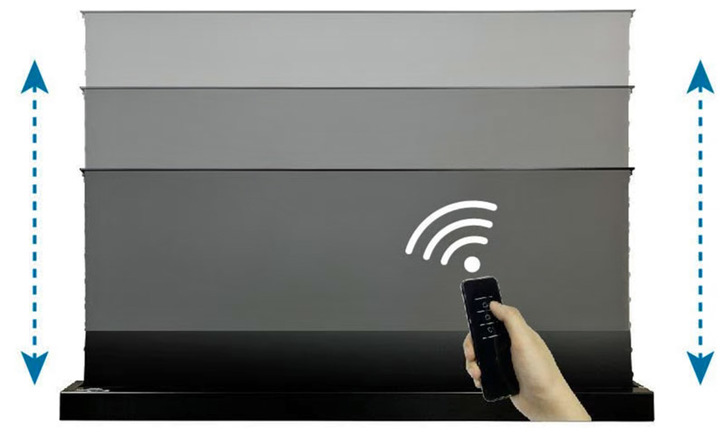
Lest you think that UST Projectors are the perfect display devices, you should know that they do involve some trade-offs. You will generally get better image quality (and a brighter picture) from a large flat panel TV. But flat panels currently max out somewhere around 100 inches, and the larger ones are still super expensive. A UST projector can give you a 120-inch image, or even larger, for less money. Traditional front projectors also can provide superior image quality to a UST projector, often at a lower overall cost. But installing a traditional projector can get a bit expensive, unless you are a DIY kind of guy (or gal). While the set-up of a UST projector and screen does require some manual labor and precision adjustments, it's typically less complicated than installing a traditional front projector.
If you're looking for a huge screen experience at home without the high cost of a giant flat panel TV or the installation complexity of a traditional home theater projector, today's UST projectors are worth a look (and a listen).
Related Articles: